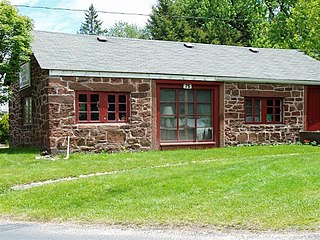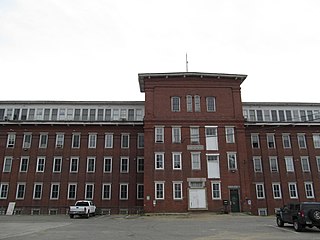
Rockville is a census-designated place and a village of the town of Vernon in Tolland County, Connecticut, United States. The population was 7,474 at the 2010 census. Incorporated as a city in 1889, it has been consolidated with the town of Vernon since 1965.

Vernon is the most populous town in Tolland County, Connecticut, United States. The population was 30,215 at the 2020 census. Vernon contains the smaller villages of Talcottville and Dobsonville. Vernon contains the former City of Rockville.

The Old Rockville High School and East School are a pair of historic former school buildings at School and Park Streets in the Rockville section of Vernon, Connecticut. Built in 1892 and 1870 respectively, the two buildings are good examples of late 19th-century school architecture, and the former high school is a particularly good example of Richardsonian Romanesque design. The buildings were listed on the National Register of Historic Places in 1981. The high school now houses school administration offices, and the East School houses court offices.

The Saxony Mill was a historic textile mill complex at 66 West Street in Rockville section of Vernon, Connecticut. With a construction history dating to 1836, it was one of the oldest surviving wood-frame textile mills in the state prior to a 1994 fire which led to its demolition. The mill complex was added to the National Register of Historic Places in 1983.

The Russell Company Upper Mill is an historic structure in Middletown, Connecticut, built in 1836 and listed on the National Register of Historic Places. The building stands at the junction of Russell Street and East Main Street in South Farms. There is a small pond to the south. East Main Street's commercial and industrial development ends there. To the north, small businesses border the street, followed by the buildings of Russell Manufacturing Company, the area's most dominant feature. Russell Street crosses Sumner Brook nearby and ascends to a large residential district to the west. The mill is currently a condo-apartment complex.

The Prospect Hill Historic District encompasses a large residential area in the Willimantic section of Windham, Connecticut. Located north of the Main Street commercial district, it was developed between about 1865 and 1930, and is one of the state's largest historic districts, with more than 800 contributing buildings. It is roughly bounded by Valley, Jackson, Bolivia, Washburn, Windham, and High Streets, and contains one of the state's largest single concentrations of Victorian-era residential architecture. It was listed on the National Register of Historic Places in 2003.

The Somersville Historic District encompasses the historic components of the mill village of Somersville in western Somers, Connecticut, United States. The district is centered on a mill complex on the Scantic River, which divides the district. The most significant years of development were between about 1835 and 1935, although the area has a history dating to the 1760s. The district was listed on the National Register of Historic Places in 1995. The Mill itself has since burned down and as of October 2018 is currently open field, although the canal structure remains in place.

The Talcottville Historic District is a historic district in the town of Vernon, Connecticut. Centered on Elm Hill Road and Main Street, it encompasses a 19th-century mill village, including archaeological remnants of very early cotton-spinning facilities, and old stone dam, and a major wood-frame mill constructed by the Talcott brothers. Also included in the village are a significant number of mill worker housing units, many dating to the middle decades of the 19th century, and an 1891 lenticular pony truss bridge, built by the Berlin Iron Bridge Company. The district was listed on the National Register of Historic Places in 1989.

The Hotchkissville Historic District is a historic district in the town of Woodbury, Connecticut, that was listed on the National Register of Historic Places in 1995. The district encompasses most of the historic village of Hotchkissville, which is centered at the junction of Washington and Weekeepeemee roads. The village began as a dispersed rural agricultural community, but developed in the 19th century with the arrival of industry, primarily the manufacture of textiles. Despite this, the village has retained a significantly rural character, and includes a broad cross-section of 18th- and 19th-century architectural styles.

Sagamore Mill No. 2 is an historic textile mill located at 1822 N. Main Street in Fall River, Massachusetts. Built in 1881, it is the oldest surviving mill of three built by the Sagamore Mill Company, one of Fall River's largest textile operations. The mill complex was added to the National Register of Historic Places in 1983.

The Springfield Street Historic District is a predominantly residential historic district south of the downtown area of Chicopee, Massachusetts. It encompasses a significant number of Queen Anne style houses built in the second half of the 19th century by wealthy residents of Chicopee, as well as housing for skilled workers at the nearby textile mills. It is centered where Springfield Street and Fairview Avenue meet. The district was listed on the National Register of Historic Places in 1991.

The Machine Shop Village District is a historic district roughly bounded by Main, Pleasant, Clarendon, Water, 2nd Streets, and B&M Railroad in North Andover, Massachusetts. The district encompasses a well-preserved former textile mill village developed in the mid-19th century, with a variety of worker and upper-class housing, and two historic mill complexes. It was added to the National Register of Historic Places in 1982.

The Warrenton Woolen Mill is a historic textile mill at 839 Main Street in Torrington, Connecticut. Founded in 1844, the mill was a major part of the local economy until its closure in 1984. Its surviving complex, dating to the early 20th century, was listed on the National Register of Historic Places in 1987. It has since been renovated into housing, as the Warrenton Mill Condominiums.

Minterburn Mill is a former textile mill complex located at 215 East Main Street, in the Rockville village of Vernon, Connecticut. Developed beginning in 1834, it was the first place in Rockville to be developed industrially, and the surviving buildings provide a view of evolutionary changes in mill architecture. The mill was listed on the National Register of Historic Places in 1984. It was converted into an apartment complex in 2016 by the state.

The Valley Falls Cotton Mill Site is the site of a historic mill at Valley Falls Park in Vernon, Connecticut. Mills were operated on the site from colonial times until 1877, when the last mill burned. The site was listed on the National Register of Historic Places in 1997.

The Hillsborough Mills are a historic textile manufacturing complex at 37 Wilton Road in western Milford, New Hampshire, near its town line with Wilton. The oldest buildings of the brick mill complex were built in 1866 as a carpet-making operation. This business failed in 1874, but the complex was acquired by other textile interests, and eventual saw success producing carpet yarns, and blankets for horses and bedding. The mills were closed in 1970, and have since been adapted for other uses. The complex was listed on the National Register of Historic Places in 2014.

The Salmon Falls Mill Historic District encompasses a historic mill complex on Front Street in Rollinsford, New Hampshire. The complex includes four major structures and seven smaller ones, on about 14 acres (5.7 ha) of land along the Salmon Falls River. They were built between about 1840 and the mid-1860s, and have an unusual architectural unity, for additions made to the buildings were done with attention to matching design elements from the existing structures. The Number 2 Mill, built in 1848, was an early location where a turbine was used instead of a waterwheel to provide power to the mill machinery. The district was listed on the National Register of Historic Places in 1980.

The Broad Brook Company was a manufacturer of textiles in East Windsor, Connecticut, which operated from the 1830s until 1954. The company plant, located on Broad Brook at Main Street and Scott Road in the town's Broad Brook village, was listed on the National Register of Historic Places in 1985. Partially destroyed by fire, with surviving buildings converted into residential condominiums in the 1980s, the complex has been shuttered due to the discovery of toxic soil conditions on the property.

The Briggs Carriage Company is a historic industrial complex at 14 and 20 Cedar Street in Amesbury, Massachusetts. Built before 1890, these two buildings are a surviving reminder of the city's late 19th century prominence as a major carriage manufacturing center. They were listed on the National Register of Historic Places in 2007.

The Home Woolen Company is a historic textile mill complex on Main Street in Beacon Falls, Connecticut. Developed between 1853 and 1916, the complex housed major local employers, engaged first in the manufacture of woolens and rubber products. The complex has been converted to residential use. It was listed on the National Register of Historic Places in 1984.























